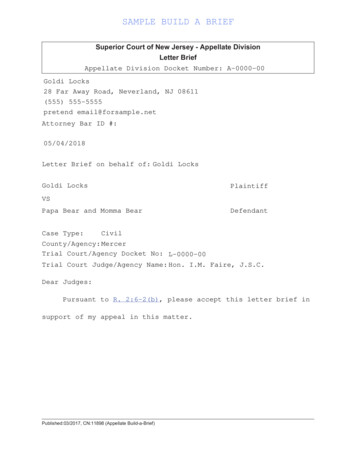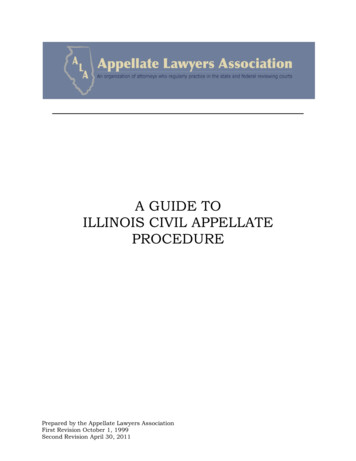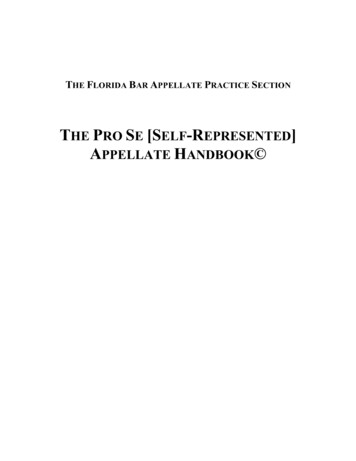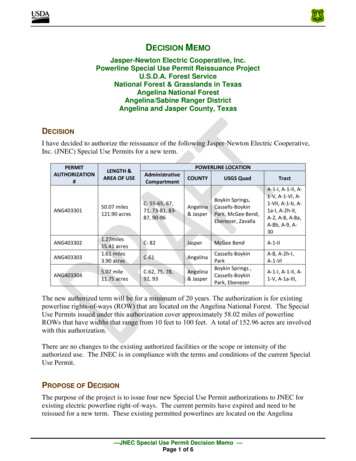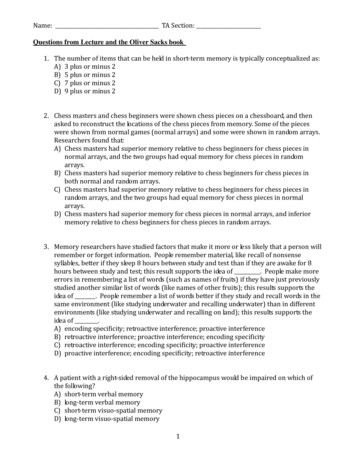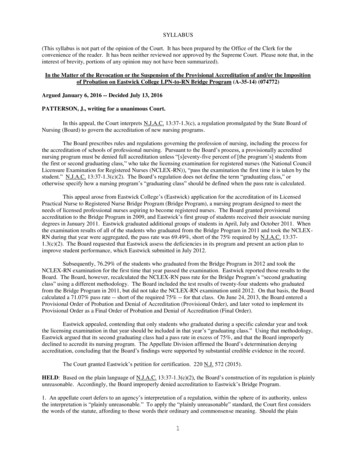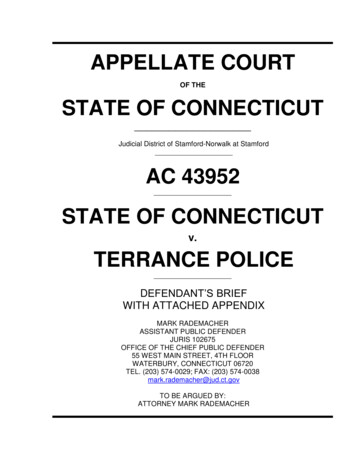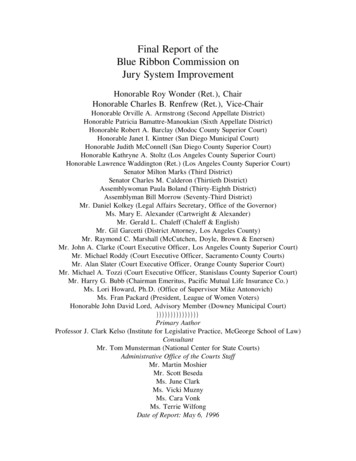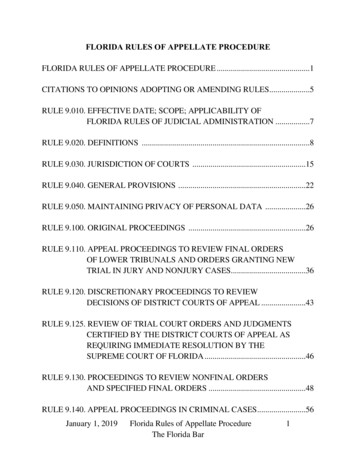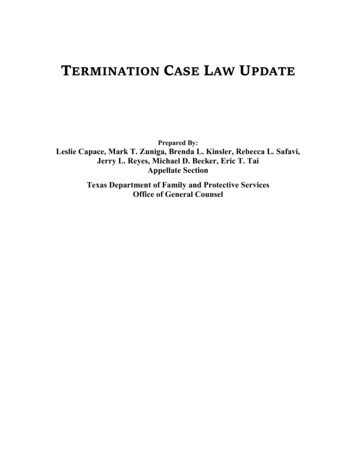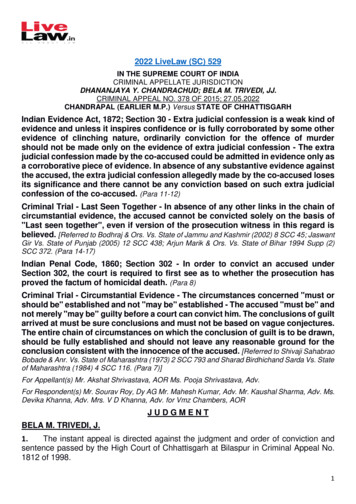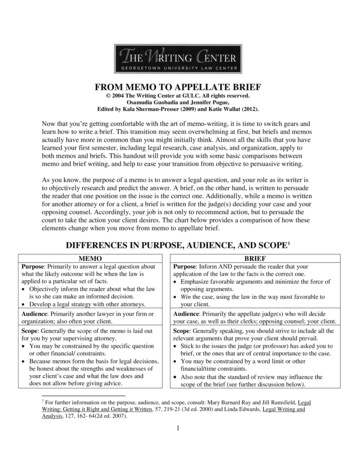
Transcription
FROM MEMO TO APPELLATE BRIEF 2004 The Writing Center at GULC. All rights reserved.Osamudia Guobadia and Jennifer Pogue,Edited by Kala Sherman-Presser (2009) and Katie Wallat (2012).Now that you’re getting comfortable with the art of memo-writing, it is time to switch gears andlearn how to write a brief. This transition may seem overwhelming at first, but briefs and memosactually have more in common than you might initially think. Almost all the skills that you havelearned your first semester, including legal research, case analysis, and organization, apply toboth memos and briefs. This handout will provide you with some basic comparisons betweenmemo and brief writing, and help to ease your transition from objective to persuasive writing.As you know, the purpose of a memo is to answer a legal question, and your role as its writer isto objectively research and predict the answer. A brief, on the other hand, is written to persuadethe reader that one position on the issue is the correct one. Additionally, while a memo is writtenfor another attorney or for a client, a brief is written for the judge(s) deciding your case and youropposing counsel. Accordingly, your job is not only to recommend action, but to persuade thecourt to take the action your client desires. The chart below provides a comparison of how theseelements change when you move from memo to appellate brief.DIFFERENCES IN PURPOSE, AUDIENCE, AND SCOPE1MEMOBRIEFPurpose: Primarily to answer a legal question aboutwhat the likely outcome will be when the law isapplied to a particular set of facts. Objectively inform the reader about what the lawis so she can make an informed decision. Develop a legal strategy with other attorneys.Purpose: Inform AND persuade the reader that yourapplication of the law to the facts is the correct one. Emphasize favorable arguments and minimize the force ofopposing arguments. Win the case, using the law in the way most favorable toyour client.Audience: Primarily another lawyer in your firm ororganization; also often your client.Audience: Primarily the appellate judge(s) who will decideyour case, as well as their clerks; opposing counsel; your client.Scope: Generally the scope of the memo is laid outfor you by your supervising attorney. You may be constrained by the specific questionor other financial/ constraints. Because memos form the basis for legal decisions,be honest about the strengths and weaknesses ofyour client’s case and what the law does anddoes not allow before giving advice.Scope: Generally speaking, you should strive to include all therelevant arguments that prove your client should prevail. Stick to the issues the judge (or professor) has asked you tobrief, or the ones that are of central importance to the case. You may be constrained by a word limit or otherfinancial/time constraints. Also note that the standard of review may influence thescope of the brief (see further discussion below).1For further information on the purpose, audience, and scope, consult: Mary Barnard Ray and Jill Ramsfield, LegalWriting: Getting it Right and Getting it Written, 57, 219-21 (3d ed. 2000) and Linda Edwards, Legal Writing andAnalysis, 127, 162- 64(2d ed. 2007).1
In addition to differences in purpose, audience, and scope, the brief and memo also have slightlydifferent components. You are already familiar with the primary components of a memo.Although the exact format and content of a brief may vary slightly in each jurisdiction, the bodyof the brief usually contains four main parts that are similar to those in the memo: the Statementof the Issues Presented for Review, the Statement of the Facts or Statement of the Case, theArgument, and the Conclusion. Most courts will also require a Table of Contents and Table ofAuthorities, as well as a Summary of the Argument and a Standard of Review. Alwaysremember to refer to your court’s rules (or your professor’s requirements) for specificrequirements. The chart below compares the main components of the memo and brief.COMPARING COMPONENTS OF THE MEMO AND BRIEF2MEMOQuestion(s) Presented: Presents anobjective statement of the legal questions tobe answered in the memo, the crux of whatyou’re writing about. Includes 3 elements: the jurisdiction, thelegal issue, and the most legallysignificant facts.Brief Answer: Provides a short answer tothe question(s) presented. Usually includes a brief explanation of thelegal basis for that answer, including someof the main legal elements or buzzwords. Generally, there are no formal citations orquotations in this section.[The Standard of Review is not typicallyincluded in memos.]BRIEFStatement of Issue(s) Presented for Review (the “IssueStatement”): Identifies and describes the legal issue(s),invokes the applicable law, describes the most legallysignificant facts. Differs from the Question Presented in point of view, as itis persuasive. An effective Issue Statement should suggestan outcome, using the relevant facts and the applicable lawto elicit an answer that affirms the analytical reasoning ofthe brief.Summary of the Argument:3 A statement that previews themajor conclusions in your brief and the reasons supportingthose conclusions. This section does not usually include formal citations orquotations, but is still specific to the client’s case underreview. Should be self-contained so that a busy reader could readonly this section and still understand the essence of yourargument. Your Theory of the Case (discussed below) should beapparent in your Summary of Argument.Standard of Review:4 The level of deference the reviewingcourt must give to the lower court’s decision. Includes citation to cases that use the appropriate standard. See further discussion below, on page 5.2For further discussion on all of these elements, consult: John C. Dernbach, Richard V. Singleton, A Practical Guideto Legal Writing& Legal Method, 18791, 21524 (2d ed. 1994); Mary Barnard Ray and Jill J. Ramsfield, LegalWriting: Getting it Right and Getting it Written, 24, 56, 62-63, 92-93, 174-76, 184-88, 289-90, 358-60, 364 (3d ed.2000); Kristen Robbins-Tiscione, Rhetoric for Legal Writers, 216-25, 237-54 (2009).3A Summary of Argument should “contain a succinct, clear, and accurate statement of the arguments made in thebody of the brief” and not “merely repeat the argument headings”. Fed. R. App. P. 28(a)(8).4For further discussion on Standards of Review, see the Writing Center handout, “Identifying and UnderstandingStandards of Review.”2
MEMOStatement of the Facts: An objective andcomplete description of the legallysignificant facts relevant to the discussionsection. Keep in mind that if you use a fact in youranalysis section, it should also appear inyour Statement of Facts. The beginning or end of this sectiontypically includes procedural history ofthe case (to the extent there is any), andwhat the client hopes to achieve.[The Statement of the Case is not typicallyincluded as a separate section in memos.While the procedural history is veryimportant in appellate briefs, it is oftennonexistent (or at least, of little importance)in memos. Thus, to the extent there is anyprocedural history in a memo, it is typicallyincluded as part of the Statement of Facts.]Discussion: The heart of the memo, whichobjectively answers the question presentedusing basic concepts of legal writing. Discusses both the strengths andweaknesses of your client’s case, usingsynthesized rules of law, and uses that lawto address arguments on both sides beforemaking a recommendation. Organized around the law, according togood small- and large-scale organization.5 Includes citations to all legal authority.Conclusion: A summary of your analysiswhich synthesizes your findings,recommends a strategy, and advises yourclient. It is a more thorough summary of theanalysis than provided in the BriefAnswer.5BRIEFStatement of the Case: A short section describing theprocedural history of the case, including the nature of the case(i.e. civil or criminal, tort or contract), the history of theproceedings, and disposition below. Some courts require a separate Statement of the Case;others expect this information to appear within yourStatement of Facts or in the Argument section. Again,always consult the court’s rules or your professor’srequirements for specific guidelines.Statement of the Facts: An account of the facts of the caseas told from your client’s perspective Should seek to make the court sympathetic to your clientby emphasizing the favorable facts and downplaying theunfavorable ones, without dishonestly omitting importantlegal facts. Your Theory of the Case (discussed below) should also beapparent to the reader from reading the facts section. Facts should generally have citations to the record below.Argument: The heart of the brief, containing your persuasiveinterpretation, analysis, and application of the law to yourclient’s case. Uses the same basic concepts of legal writing in the memo,including rule synthesis, large- and small-scaleorganization and case analysis. Should seek to shape thelaw and by doing so preempt opposition’s points. Should highlight strengths in your client’s case andminimizes its weaknesses, presenting the law from theperspective most favorable to your client. The Theory of the Case (discussed below) should bewoven throughout your Argument.Conclusion: States exactly what it is you want the court todo. A court will not grant relief that is not requested, so theconclusion should state the relief sought precisely. Unlike in the memo, the conclusion in a brief should nothave any law or reasoning. It is often a single sentence, i.e., “For the reasons above,the lower court’s decision should be affirmed.”For further discussion on organization, see the Writing Center handout, “Crafting Mid-level Organization.”3
THE THEORY OF THE CASE6One of the challenges of writing a brief for the first time is grasping the concept of the Theory ofthe Case (or the “Core Theory”). Because a memo presents an objective application of the factsto the law, there is no Theory of the Case in a memo. It is a tool unique to persuasive writing.The Theory of the Case is the unifying idea or concept of the case. It is the completion of thesentence “My client should win because . . .” It is the implicit message in your brief that will tietogether the factual, legal, and policy issues. It is not a legal theory like negligence or selfdefense. Rather, it is a simple, factual theory that will help your reader empathize with yourclient and see the facts in a way that is most favorable to your client. While the facts explainwhat happened, and the law explains the legal implications of what happened, the theoryexplains why it happened.Your Theory of the Case should be evident throughout your brief, particularly in yourSummary of Argument, Statement of Facts, and throughout your Argument. The theory shouldmesh with your organizational framework and be supported by the facts of your case andrelevant law. It should be subtle, woven throughout your document so that your reader is able toarticulate it after reading your brief, even though you don’t state it outright. The persuasivepower of your Theory of the Case is it allows your reader to sympathize with your client evenbefore she understands the relevant law. For this reason, it is important to take advantage of thetheory’s opportunities for persuasion early on in your brief.A Theory of the Case should unify the various parts of the brief. In a brief with multiplelegal issues or elements, a single unifying theme helps the reader to process all the differentcomponents. You will find that developing a strong Theory of the Case is particularly necessarywhen you are dealing with new or unsettled areas of the law. In such a situation, judges may bemore open to a new perspective on the issue.When determining an effective Theory of the Case, brainstorm a number of potential theoriesand consider the advantages and disadvantages of each one. Your intended audience, the legaland factual framework of the case, and the organization of your brief may influence your choiceamong legal theories. You should also consider what theory your opponent is likely to choose, asthis may influence your decision to choose one theory over another.7Examples of Theories of the Case: You are representing a party injured in a car accident. Your legal theory might be that theother driver was negligent, but your Theory of the Case might be that “he was in a rush.”Throughout the brief, you highlight facts that support your Theory of the Case, for examplethat the driver was speeding, late for an appointment, or not paying attention.8You are representing a state prison in a case where a prison warden has imposed severalrestrictions on the prisoners. Instead of treating each restriction as separate and unrelated6Diana R. Donahoe, Legal Research & Writing (Aspen 2006, 3d ed. 2008).Id.8Id.74
from one another, a unifying theory could be that the restrictions, as a set,constitute a necessary and appropriate security plan for the prison. Each restriction is thenvalid as an integral part of a prison security plan, and you’ve presented your client’s actionsin a favorable light.If you represent an indigent client who stole food to feed his family, your Theory of the Casemight be that your client had no choice. Tugging at the judge’s heartstrings is often aneffective way to get her to rule in your favor.9 Using this theory, you could craft yourStatement of Facts to emphasize your client’s difficult financial situation. In your Argumentsection, you would highlight these facts to bolster your legal arguments.PERSUASIVE WRITING TECHNIQUES10Once you’ve developed your Theory of the Case, you can begin examining persuasive writingtechniques. Here are several things to keep in mind as you begin to write your brief:1. Standard of Review in Appellate Briefs:The standard of review is the level of deference the appellate court must give to the lower court’sdecision. It determines the latitude afforded to an appellate court to substitute its judgment forthat of the trial court. The standard of review adopted in a case will depend on the nature of thecase and the case’s procedural posture when the lower court’s decision was issued. It will varyfrom state to state and from issue to issue.11In order to determine the applicable standard of review for your case, you will need to researchprior cases in your jurisdiction that address the same issues you are addressing in your brief. Thestandard of review is usually described toward the beginning of the opinion. As an advocate foryour client, you should be looking for authority, including policy arguments, that supports themost favorable standard of review possible. If you’re representing the appellant, you shouldargue for the least restrictive standard, the standard that maximizes appellate court’s authority tooverturn the challenged decision. If you represent the appellee, on the other hand, you shouldargue for the most restrictive standard, one that limits the appellate court’s authority to overturnthe trial court’s ruling.12The standard of review is critical because it defines the scope of issues that the court willactually be reviewing. Thus, it will inform the scope of your brief. If you are writing about afactual issue and the applicable standard of review is clearly erroneous, you will need to focuson the facts of the case and why the court below did or did not make any errors. Under thisstandard, your Issue Statement might focus on the lower court’s mistakes.For further discussion, see the Writing Center handout “Identifying and Understanding Standardsof Review.”9Id.For further, more in-depth discussion of persuasive writing, see the Writing Center handout “Persuasive Writing.”11Questions of fact are usually entitled to the greatest level of deference on appeal, and are not usually reversedunless clearly erroneous. In contrast, questions of law are often reviewed without any deference at all, called de novoreview. There is no universal standard of review for mixed questions of law and fact, and different courts treat thesequestions differently. Kristen Robbins-Tiscione, Rhetoric for Legal Writers, 239 (2009).12Linda Edwards, Legal Writing and Analysis, 199 (2d ed. 2007)105
2. Purpose:Let the purpose of your brief inform all the choices you make throughout your brief, from youroverall organization to your word choices. Every single component of your brief should bewritten in a manner that will convince your audience that your argument is the correct one.Always ask yourself, “Could I revise or change my brief in any way that will make my client’scase seem stronger?”3. Organization:In organizing the arguments in your brief, consider which structure will maximize thepersuasiveness of your arguments while still making them easy to follow. Organizing a brief isoften different than structuring a memo, where the parts are usually organized to maximizeunderstanding of the legal issues. When organizing your brief, think about the relative strengthsand weaknesses of your arguments, their proportioning, and their flow. Most legal writers chooseto open with their best arguments. However, you will have to balance the relative strength ofyour arguments with what makes sense logically and chronologically. When choosing yourorganization, consider your Theory of the Case and make sure that your Theory fits within theorganizational framework.You should also be conscious of the amount of space you spend discussing each argument.Because both judges and professors usually have strict word limits, you will have to prioritizewhich arguments you will make and how much space to devote to each. Your strongestarguments should have the largest proportion of your brief’s words, which helps convey theirimportance. Remember, too, to address the counterarguments, while keeping your ownarguments at center stage.4. Point Headings:Point headings are an important part of your persuasive presentation of your argument in anAppellate Brief. It is usually the first language a judge (or professor) will see in reviewing yourbrief, so it is important to guide your reader to your conclusions in your point headings. Forfurther discussion and specific examples, see the Writing Center Handout “Writing EffectivePoint Headings”.OTHER RESOURCES Laurel Currie Oates & Anne Enquist, Just Briefs, (2003).John C. Dernbach, Richard V. Singleton, A Practical Guide to Legal Writing& LegalMethod, (2d ed. 1994).Mary Barnard Ray and Jill J. Ramsfield, Legal Writing: Getting it Right and Getting itWritten, (3d ed. 2000).Kristen Robbins-Tiscione, Rhetoric for Legal Writers, (2009).Linda Edwards, Legal Writing and Analysis, (2d ed. 2007).Teaching Law E-book.Writing Center Handouts, available at www.law.georgetown.edu/writingcenter.6
objective statement of the legal questions to be answered in the memo, the crux of what you're writing about. Includes 3 elements: the jurisdiction, the legal issue, and the most legally significant facts. Statement of Issue(s) Presented for Review (the "Issue Statement"): Identifies and describes the legal issue(s),
